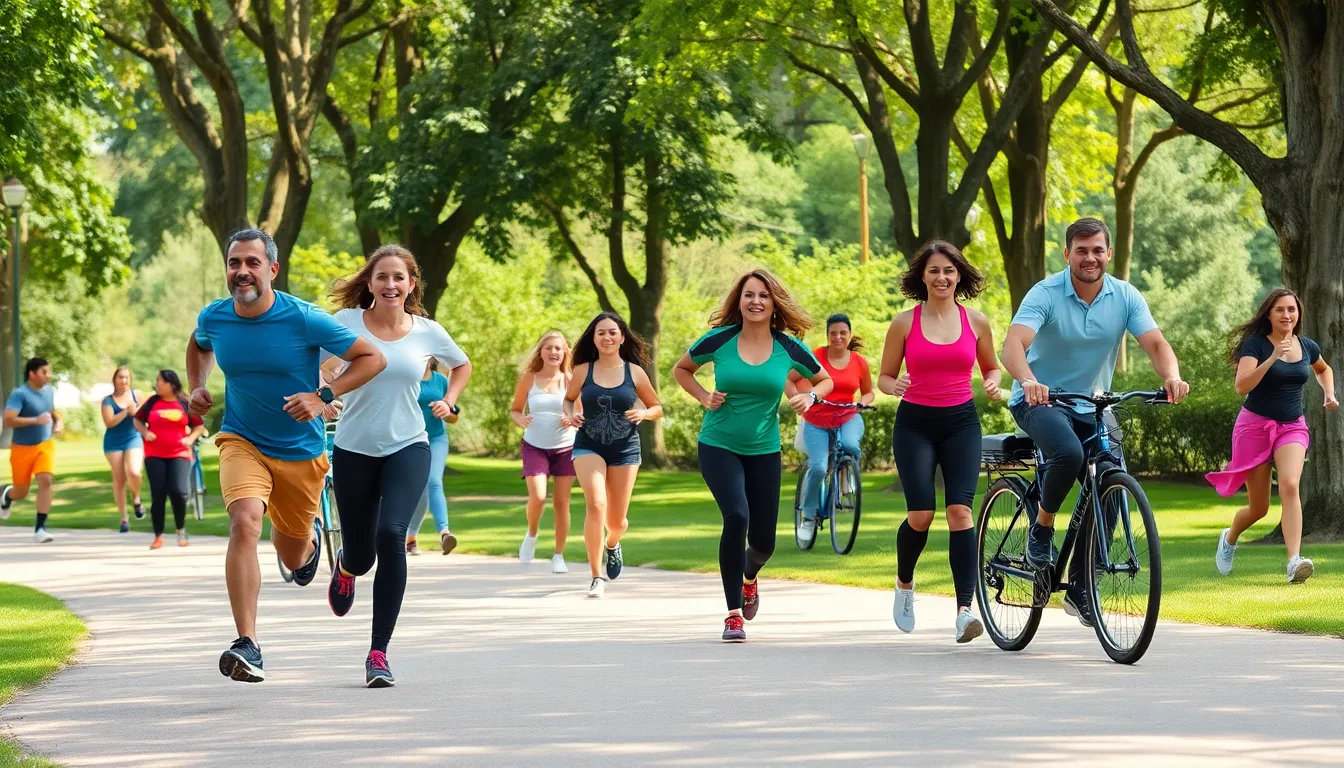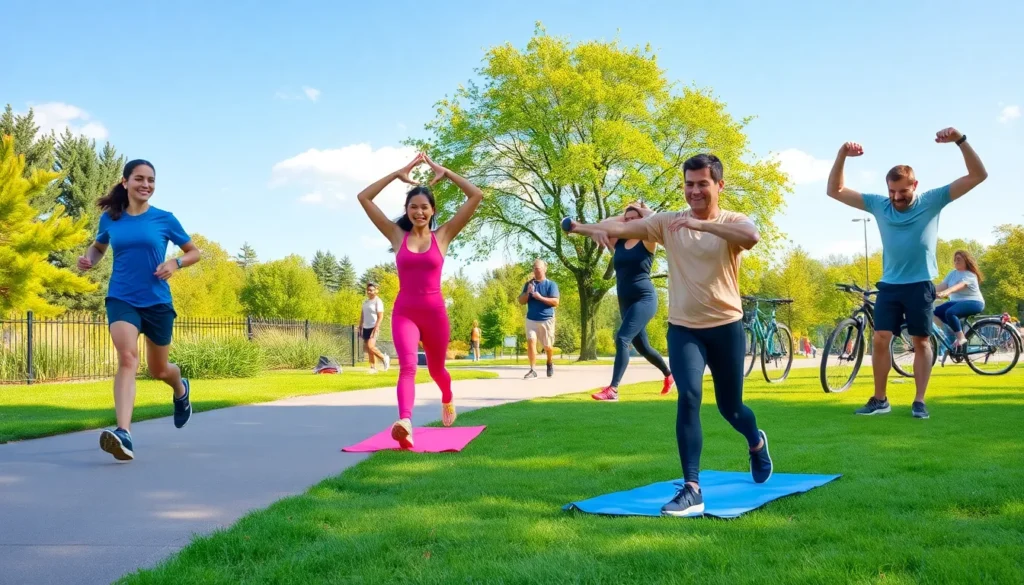When it comes to exercising, the options can feel overwhelming. From yoga that promises inner peace to high-intensity workouts that leave you gasping for air, there’s a type of exercise to suit every personality and fitness goal. Whether you’re a couch potato looking to morph into a fitness guru or a gym rat searching for that next adrenaline rush, the right exercise can make all the difference.
Type Of Exercises
Exercises can be categorized into several distinct types, each serving unique benefits. Aerobic exercises improve cardiovascular health through steady, rhythmic activities. Examples include running, cycling, and swimming. Strength training enhances muscle mass and boosts metabolism, utilizing resistance through weights, bands, or body weight. Common examples are weightlifting, push-ups, and resistance band workouts.
Flexibility exercises maintain range of motion in the joints and improve overall mobility. Yoga and stretching routines exemplify flexibility workouts. Balance exercises promote stability and coordination. Examples consist of tai chi and stability ball exercises.
High-Intensity Interval Training (HIIT) combines cardio and strength components for maximum efficiency. This approach alternates short bursts of intense exercise with recovery periods, making it an effective workout for busy schedules.
Mind-body exercises focus on the connection between mental and physical health. Pilates and yoga fall under this category. They enhance mindfulness and body awareness while promoting relaxation.
Functional exercises mimic daily activities, improving overall strength and endurance. Squats, lunges, and kettlebell swings provide real-world benefits.
Incorporating a variety of these exercises allows for a balanced fitness regimen. Each type supports specific health goals, enhancing overall well-being. Balancing strength, cardio, flexibility, and mindfulness creates a comprehensive approach to fitness.
Aerobic Exercises

Aerobic exercises provide significant health benefits and training for cardiovascular endurance. They enhance heart and lung function while promoting overall fitness.
Benefits Of Aerobic Exercises
Aerobic exercises improve cardiovascular health substantially. They lower the risk of heart disease, hypertension, and diabetes. Increased stamina and energy levels accompany regular aerobic activity. Participants often experience elevated moods due to the release of endorphins. Weight management becomes more manageable, as aerobic exercises burn calories efficiently. Enhanced lung capacity and respiratory fitness result from consistent aerobic training. Overall, these exercises support a healthy and balanced lifestyle, making them essential for long-term well-being.
Popular Aerobic Activities
Popular aerobic activities include running, cycling, and swimming. Dancing often incorporates rhythmic movement for enjoyment and fitness. Group fitness classes, such as Zumba and step aerobics, provide social engagement during workouts. Hiking immerses individuals in nature while delivering excellent cardiovascular benefits. Rowing, whether on water or machines, offers a full-body workout. Jumping rope increases agility and improves coordination. Other options like kickboxing integrate aerobic conditioning into martial arts. These activities cater to diverse preferences, ensuring everyone can find an enjoyable way to incorporate aerobic exercise into their routine.
Strength Training Exercises
Strength training exercises build muscle, enhance metabolism, and improve overall physical performance. This type of workout plays a crucial role in maintaining muscle mass, especially as individuals age.
Importance of Strength Training
Strength training strengthens bones and joints, reducing the risk of injuries. It enhances athletic performance by improving power and endurance. Additionally, muscle-building activities boost metabolic rate, contributing to effective weight management. Regular strength workouts decrease body fat and promote better posture and balance. Health experts emphasize that incorporating strength training into a fitness routine leads to long-term health benefits and improved functional abilities for daily activities.
Common Strength Training Exercises
Common exercises fall into several categories, offering a variety of options to suit different fitness levels. Squats target the legs and glutes, while bench presses focus on the chest and arms. Deadlifts provide a total body workout, engaging the back, legs, and core. Push-ups strengthen the chest, triceps, and shoulders. Resistance bands and free weights enhance these moves, allowing for greater customization in routines. Others include lunges for leg strength and planks for core stability. Incorporating a mix of these exercises promotes balanced muscle development and supports overall fitness goals.
Flexibility And Stretching Exercises
Flexibility and stretching exercises enhance overall fitness, promoting joint mobility and muscle elasticity. Incorporating these practices into routines improves physical performance and injury prevention.
Advantages Of Flexibility Training
Flexibility training offers several key benefits. Improved range of motion enhances performance in various physical activities. Regular stretching reduces muscle tension, leading to decreased risk of injury. Enhanced circulation promotes nutrient flow to muscles, aiding recovery after workouts. Additionally, flexibility training can alleviate stress and improve posture. Practicing these exercises regularly fosters better body awareness and balance, contributing to overall well-being.
Effective Stretching Techniques
Effective stretching techniques can significantly boost flexibility. Static stretching involves holding a stretch for 15 to 60 seconds, targeting major muscle groups. Dynamic stretching incorporates controlled movements, such as leg swings or arm circles, preparing muscles for activity. Proprioceptive neuromuscular facilitation (PNF) combines stretching and contracting, often requiring a partner for optimal results. Incorporating these techniques into a fitness routine enhances flexibility, promotes recovery, and minimizes stiffness. Regular practice of effective stretching techniques yields long-lasting benefits for daily activity and exercise performance.
Balance And Stability Exercises
Balance and stability exercises play a crucial role in overall fitness and injury prevention. These exercises enhance coordination, improve stability, and support daily activities, making them essential for individuals of all ages.
Why Balance Is Important
Balance is vital for maintaining physical stability in daily life. It helps prevent falls, particularly in older adults, and minimizes the risk of injury during physical activities. Strong balance contributes to better posture and body awareness, which can enhance athletic performance. Improved balance enhances functional movements, such as walking, running, and climbing stairs. Maintaining stability fosters independence as individuals age, allowing them to engage in activities without fear of falling.
Exercises To Improve Balance
Various exercises effectively improve balance and stability. Single-leg stands challenge coordination and promote strength in the lower body. Tai chi offers a combination of movement and mindfulness, enhancing overall stability. Balance boards or stability balls engage core muscles and improve proprioception. Heel-to-toe walking encourages focus and strengthens the ankle muscles. Incorporating these exercises into a routine enhances balance and contributes to overall fitness, improving performance in daily tasks and physical activities.
Conclusion
Finding the right type of exercise is essential for anyone looking to enhance their fitness journey. With so many options available it’s easier than ever to tailor workouts to individual preferences and goals. Incorporating a mix of aerobic, strength, flexibility, and balance exercises ensures a well-rounded approach that supports overall health and well-being.
Whether it’s the thrill of a high-intensity workout or the calm of yoga each type of exercise offers unique benefits. By exploring and integrating various exercises individuals can create a sustainable routine that not only meets their fitness aspirations but also enriches their daily lives. Embracing this diversity in workouts can lead to lasting physical and mental improvements.



